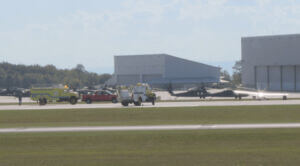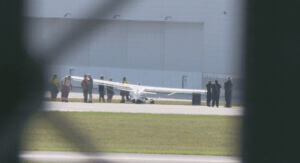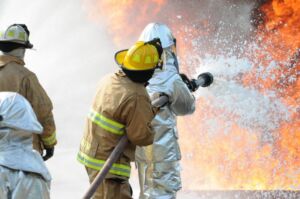We close out the month of September with these stories...
Be safe out there!
Tom
-
Officials: Plane makes 'hard landing' at Johnstown Airport, no injuries reported
by WJAC staff
JOHNSTOWN, Pa. (WJAC) — Emergency crews in Cambria County were called to the Johnstown Airport Sunday afternoon following reports of a downed aircraft.
Cambria County were called to the Johnstown Airport Sunday afternoon following reports of a downed aircraft.
Richland Fire Chief Wes Meyers tells 6 News that at around 3:30 p.m. Sunday, a single-engine Piper airplane experienced issues and made a 'hard landing' back onto the runway, shortly after taking off.
Meyers says the plane, which had two people onboard, had only risen about 30 feet off the ground before making the hard landing. He tells 6 News that neither passenger was injured, but the plane did experience a fuel leak after the incident.
He says crews on scene were able to stop the leak and clean the area. As of around 5 p.m. Sunday, airport crews were in the process of contacting the Federal Aviation Administration, which will coordinate the removal of the plane from the runway.
and clean the area. As of around 5 p.m. Sunday, airport crews were in the process of contacting the Federal Aviation Administration, which will coordinate the removal of the plane from the runway.
6 News has reached out to the FAA for comment but has not yet received a response.
https://wjactv.com/news/local/plane-makes-hard-landing-at-johnstown-airport-no-injuries-reported
Light plane makes safe emergency landing on I-15 in Tierrasanta
By City News Service
The pilot of a light airplane made a safe rush-hour emergency landing on Interstate 15 in Tierrasanta Monday.
emergency landing on Interstate 15 in Tierrasanta Monday.
The single-engine aircraft touched down on the northbound side of the freeway near Aero Drive at about 4:45 p.m. Monday, according to the California Highway Patrol.
Passers-by reported that the plane landed without incident, making no contact with any vehicles on the freeway and rolling to a stop in the center divider area, the CHP advised. The pilot appeared to be the sole occupant of the aircraft, witnesses said.
No injuries were reported.
https://www.kpbs.org/news/public-safety/2025/09/29/light-plane-makes-safe-emergency-landing-on-i-15-in-tierrasanta
State launches disposal program for toxic firefighting foams
Collecting and properly disposing of "forever chemicals"
Department of Ecology – State of Washington
Todd Metrokin
Ecology is partnering with fire departments across the state to help protect firefighters from exposure to per- and polyfluoroalkyl substances – or PFAS – in firefighting foams.
the state to help protect firefighters from exposure to per- and polyfluoroalkyl substances – or PFAS – in firefighting foams.
PFAS are resistant to heat which is one reason they are added to firefighting foams. But they also build up in people, animals, and the environment over time. Because many PFAS don’t break down easily, they’re often called “forever chemicals.”
Firefighting foams containing PFAS are known to contribute to the disproportionately high levels of PFAS in firefighters’ bodies. That’s a concern because PFAS are linked to multiple health issues, including cancer.
In 2018, Washington passed the Firefighting Agents and Equipment law. With its passage, Washington became the first state in the nation to restrict the sale, manufacture, and distribution of “aqueous film-forming foams” or AFFF, which are a group of PFAS containing firefighting foams. The law also prohibits local governments and state agencies from training with these foams—but existing stock can still be used to fight fires.
That’s why we're launching an AFFF disposal program. Through this program, a permitted hazardous waste service provider will collect PFAS firefighting foams from nearly 80 fire departments across the state. A federally approved incinerator will then safely destroy the waste once it’s collected.
“Fire departments regularly call, asking us what to do with their AFFF. They don’t want the environmental and occupational exposures to PFAS,” said Sean Smith, who leads Ecology’s work to implement the Product Replacement Program. “Removing foams with PFAS from service is important because it eliminates a highly concentrated source of PFAS pollution in Washington.”
Some fire departments have taken steps to dispose of their AFFF on their own. Proper disposal of AFFF isn’t easy, though. State regulations require PFAS-contaminated waste to be managed and disposed of at a federally permitted hazardous waste facility. This can cost about four times more than disposal at a municipal landfill.
Ecology’s AFFF disposal program helps reduce costs by covering collection and disposal expenses. This makes proper AFFF disposal more feasible for fire departments, whether they’re small rural volunteer agencies or larger departments with more sizeable stockpiles. It also means the PFAS mass is destroyed to the greatest extent possible with minimal environmental and public health impact. Fire departments interested in participating in the program should visit Ecology’s AFFF Collection and Disposal Page.
More ways we’re protecting first responders from PFAS
Reducing significant sources of PFAS, like AFFF, is critical for preventing environmental contamination and protecting public health. Here are other ways we’re reducing the use of AFFF and preventing first responders’ exposure to PFAS:
- We provided test boxes to several commercial airports. These boxes allow airports to test fire suppression systems without releasing AFFF, eliminating a significant source of PFAS pollution.
- We implement the state Firefighting Agents and Equipment law, which restricts the manufacture, sale, and use of class B firefighting foams with intentionally added PFAS.
- We partnered with other states to develop best management practices for deep cleaning fire equipment contaminated with PFAS firefighting foam.
- We’re also searching for potential safer alternatives to PFAS in firefighting personal protective equipment (PPE). We recently proposed a rule to require manufacturers to provide information about how they’re using PFAS in firefighting PPE, so we can look for potentially safer alternatives.
NTSB Final Report: Cirrus Design Corp SR22
Student Pilot Added Engine Power To Execute A Go-Around But Could Not Stop The Airplane’s Left Drift
Location: Cleburne, Texas Accident Number: CEN25LA324
Date & Time: August 13, 2025, 13:00 Local Registration: N654CD
Aircraft: Cirrus Design Corp SR22 Aircraft Damage: Substantial
Defining Event: Loss of control in flight Injuries: 1 None
Flight Conducted Under: Part 91: General aviation - Instructional
Analysis: The student pilot stated for the preparation for his initial solo flight, he successfully completed three takeoffs and landings with his flight instructor at the airport that was planned to be used for the solo flight. During the solo flight, the student pilot completed two full stop landings without any issues prior to attempting a third takeoff and landing. The student pilot stated that during the third attempt, the airplane crossed the runway threshold about 82 to 84 kts with full wing flaps. When the airplane crossed over the runway numbers, he reduced the engine power to idle, and the airplane entered a normal float but began to drift left. He tried to arrest the drift with rudder application, but he could not maintain the runway centerline. The student pilot added engine power to execute a go-around but could not stop the airplane’s left drift. The airplane impacted the ground in a left wing and nose down attitude, which resulted in substantial damage to the left wing, the engine firewall, and the rudder. The student pilot stated there was no mechanical malfunction/failure of the airplane that would have precluded normal airplane operation.
Probable Cause and Findings: The National Transportation Safety Board determines the probable cause(s) of this accident to be -- The student pilot’s failure to maintain airplane directional control during the approach and subsequent go-around.
FMI: www.ntsb.gov

Today in History
50 Years ago today: On 30 September 1975 Malev flight 240, a Tupolev Tu-154 crashed into the sea while on approach to Beirut Airport, Lebanon , killing all 60 occupants.
| Date: | Tuesday 30 September 1975 |
| Time: | 03:44 LT |
| Type: | Tupolev Tu-154A |
| Owner/operator: | Malev Hungarian Airlines |
| Registration: | HA-LCI |
| MSN: | 74A053 |
| Year of manufacture: | 1974 |
| Total airframe hrs: | 1186 hours |
| Engine model: | Kuznetsov NK-8-2U |
| Fatalities: | Fatalities: 60 / Occupants: 60 |
| Other fatalities: | 0 |
| Aircraft damage: | Destroyed, written off |
| Category: | Accident |
| Location: | 10 km off Beirut International Airport (BEY) - Lebanon |
| Phase: | Approach |
| Nature: | Passenger - Scheduled |
| Departure airport: | Budapest-Ferihegy Airport (BUD/LHBP) |
| Destination airport: | Beirut International Airport (BEY/OLBA) |
| Confidence Rating: | Information is only available from news, social media or unofficial sources |
Narrative:
Malev flight 240, a Tupolev Tu-154 crashed into the sea while on approach to Beirut Airport, Lebanon , killing all 60 occupants.
Flight 240 departed Budapest at 23:10 on a flight to Beirut, Lebanon. After contacting Beirut at the flight was cleared to descend to 6000 feet. As the ILS localizer was unserviceable at midnight, the flight had to carry out an NDB approach to runway 18 in night-time conditions with a visibility of 20 km below clouds.
The aircraft crashed into the water, 6 miles from the runway.
Eyewitnesses have stated that there was fire or explosion in flight, but there is no evidence to support these statements. No part of the wreckage was recovered and no burn marks or evidence of any metal from an explosion were found on any of the bodies submitted for autopsy.
